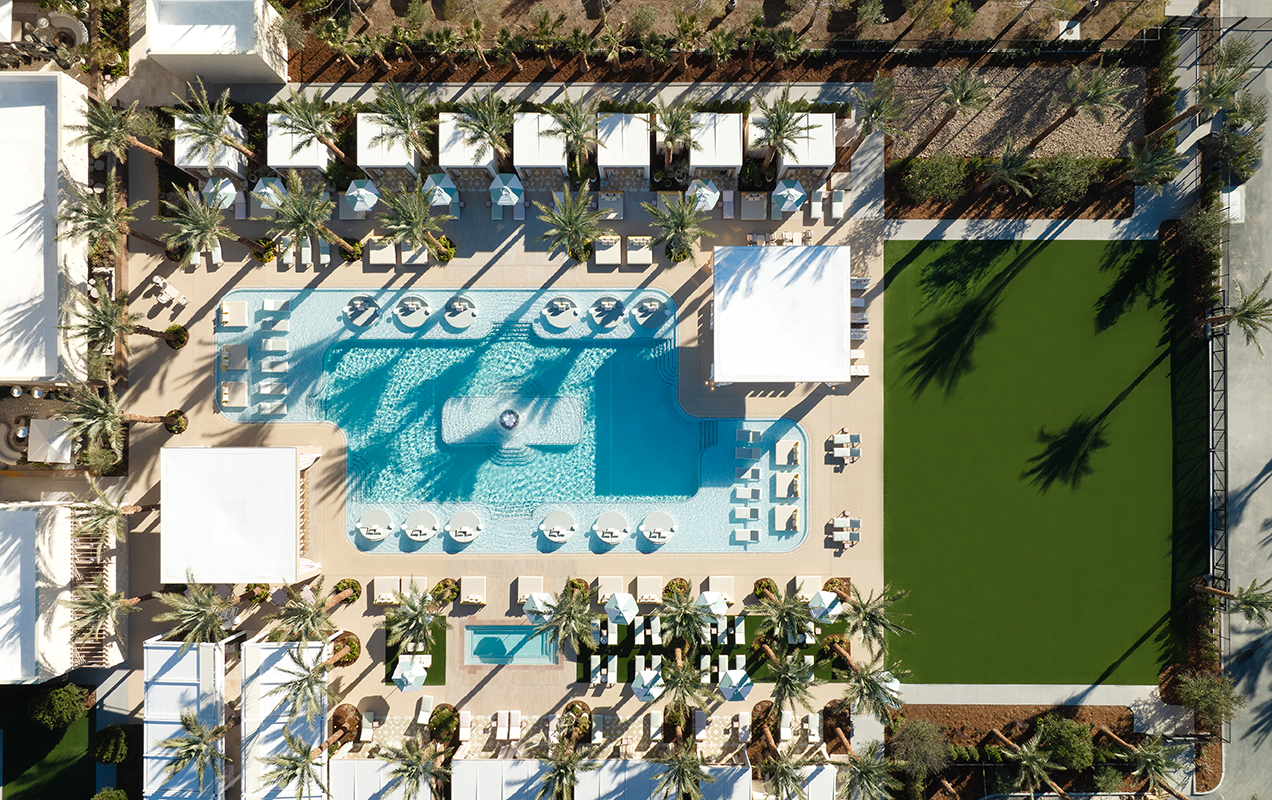In many artforms, the careful creation of visual depth and layering draws the viewer’s eye in and reaches out to envelop them in another world. While artists must calculate this into whatever medium they employ, nature creates this on its own by offering a landscape that infinitely continues past trees, rivers, hills, and clouds. As landscape architects, our palette blends people, plants, water, light, hardscape, and the land itself to create a new world.
We have all visited “designed” places that lack the charm that draws us in and encourages us to explore and stay longer. At Lifescapes, we call those spaces, “Un” (“un”creative, “un”inspired, etc.).
On the other hand, people inherently know when they are in a space that has been thoughtfully laid out and accessorized, regardless of the style or price point, because it feels comfortable, yet invigorating, to the senses. The guest may not be able to put their finger on what implores them to dive deeper into a space, but they know it, they stay longer and come back to experience it again. That sense of immersion is what we strive to bring to every project Lifescapes works on.
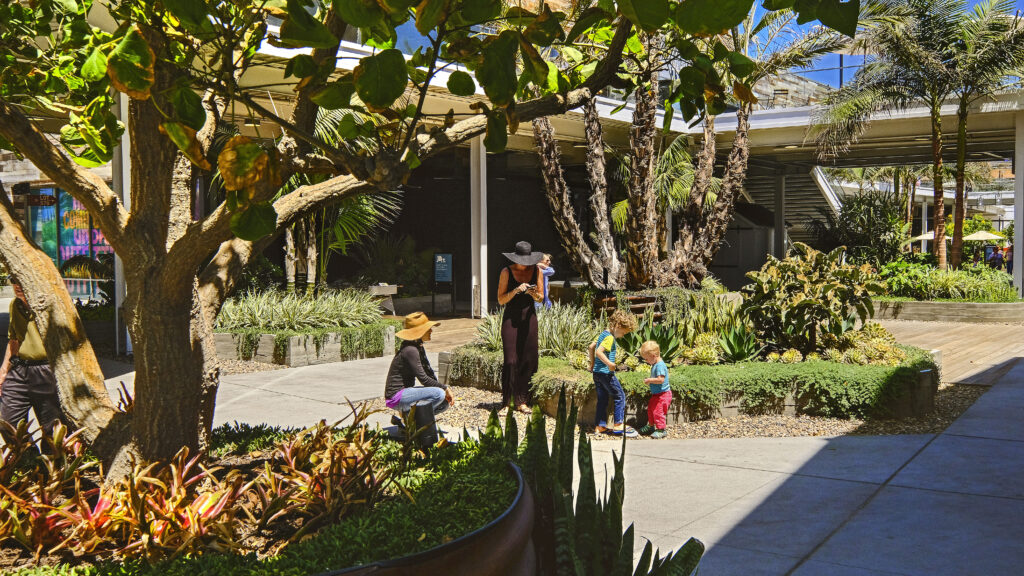 Our overall goal is a thoughtful balance of hardscape and softscape. This begins by considering the intended use of the space and laying out its structure to best fit those needs, connections, and adjacencies. However, if we were to stop there, we would have a place that technically works but feels uninviting. What sets our designs apart is the understanding that what draws people in is creating a lush, detailed setting that tempers functionality with fantasy.
Our overall goal is a thoughtful balance of hardscape and softscape. This begins by considering the intended use of the space and laying out its structure to best fit those needs, connections, and adjacencies. However, if we were to stop there, we would have a place that technically works but feels uninviting. What sets our designs apart is the understanding that what draws people in is creating a lush, detailed setting that tempers functionality with fantasy.
Because of their obvious immense size, trees are usually the first thing a guest sees and are fittingly one of the most important tools in design. Their verticality and grandeur can make a bold statement or be used to lead the eye towards (or sometimes away from) a specific view. Their canopies provide intimacy and shade, which can be arranged to set scenes, add to a sense of privacy or uncover a new discovery. Furthermore, their leaf size, shape, seasonal color changes, and flowers add to the richness of the landscape throughout the year.
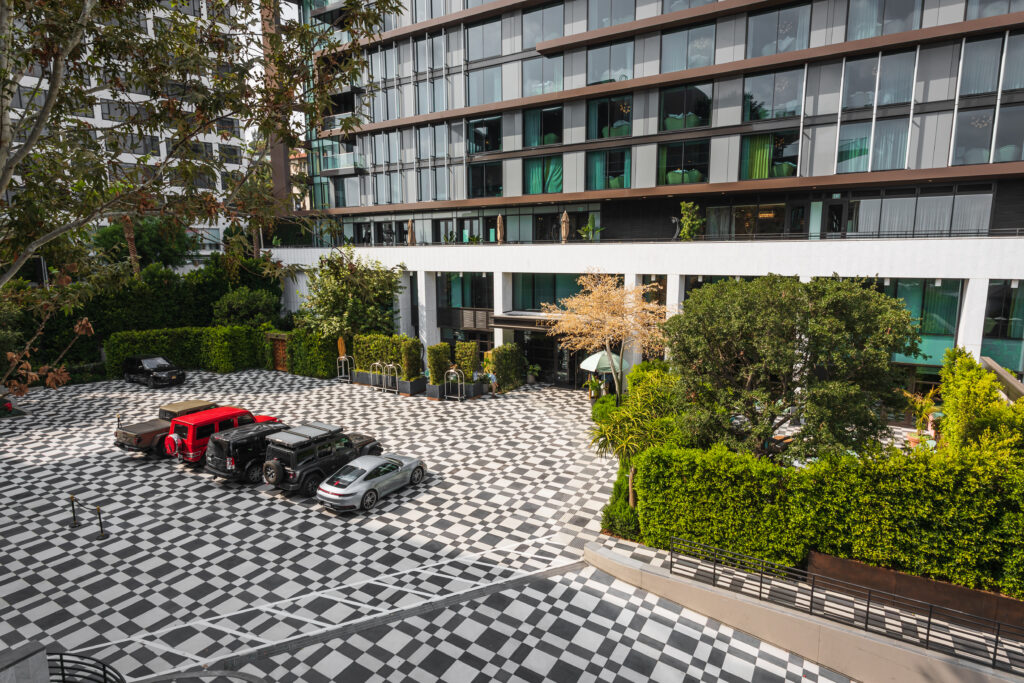 We used trees to set a scene in the gardens of the motor court of The Pendry West Hollywood Hotel & Residences. Large California Sycamores and Coastal Live Oaks line the adjacent towers, cradle the space, and reduce it to an intimate scale for arriving and departing guests. A series of 10’ high Ficus hedges act as green walls against the surrounding neighborhood to break the space down into more sheltered garden rooms, enticing those outside to wonder what might be hidden beyond. There’s even a 15’ tall vine and hedge frame that provides a beautiful backdrop while screening a loading dock.
We used trees to set a scene in the gardens of the motor court of The Pendry West Hollywood Hotel & Residences. Large California Sycamores and Coastal Live Oaks line the adjacent towers, cradle the space, and reduce it to an intimate scale for arriving and departing guests. A series of 10’ high Ficus hedges act as green walls against the surrounding neighborhood to break the space down into more sheltered garden rooms, enticing those outside to wonder what might be hidden beyond. There’s even a 15’ tall vine and hedge frame that provides a beautiful backdrop while screening a loading dock.
Below the trees in The Pendry’s motor court, a mixed variety of unique shrubs and succulents imply a private residential garden that has grown and filled in over many years. Large tree aloes, various agaves and jade plants, Yellow Bells, and Blue Chalksticks weave together into a picture that only gets more interesting as you move closer. At the motor court, a modern version of a classical Italian piazza is created with a “carpet” of black and white Art Deco concrete pavers. A custom-designed Ipe wood and brass door by Lifescapes, cut into one of the tall hedge walls, continues that design style vertically and creates an exclusive garden entry for the members-only club, The Britely.
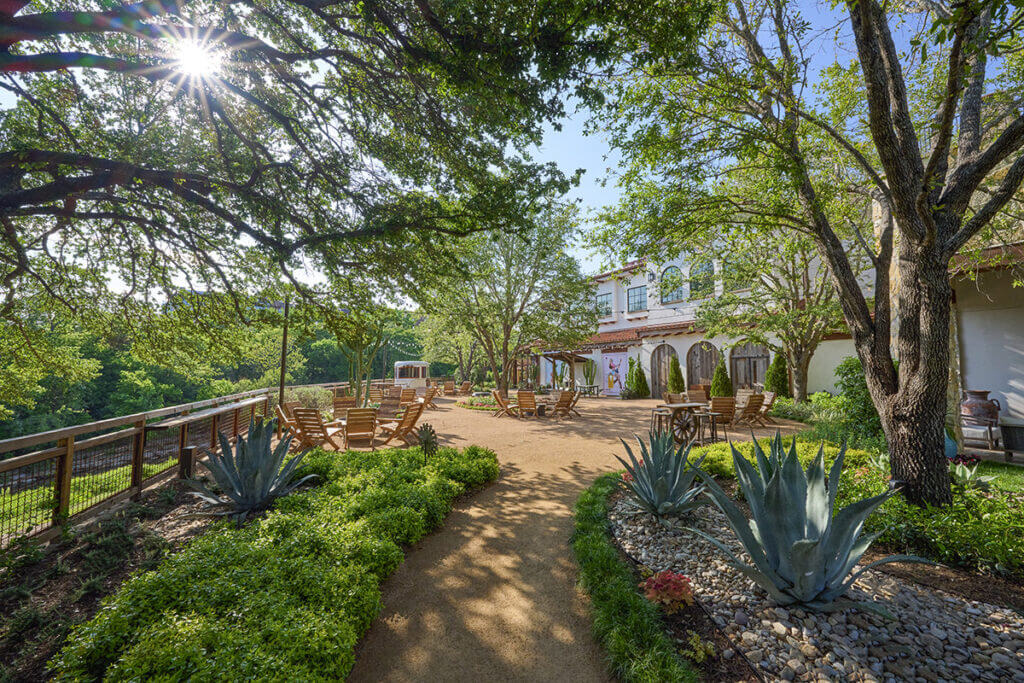 Large trees are also a hallmark of the gardens that we created for the Hotel Drover at the Fort Worth Stockyards in Texas. We arranged large Coastal Live Oaks to offer a chic, rustic, shaded place for guests to unwind and have a drink that feels like it has always been a part of the existing woodlands that surround the adjacent Marine Creek.
Large trees are also a hallmark of the gardens that we created for the Hotel Drover at the Fort Worth Stockyards in Texas. We arranged large Coastal Live Oaks to offer a chic, rustic, shaded place for guests to unwind and have a drink that feels like it has always been a part of the existing woodlands that surround the adjacent Marine Creek.
Lower scale and understory planting are also a major part of a layered experience, and even more so when it comes to the creation of distinct spaces as it is more on a human scale – very close and touchable. Shrubs allow us to form garden rooms through masses of planting that can sculpturally undulate or stretch out into classical patterns. Color, texture, and scent are all attributes that we use to paint the landscape, while expanses of turf not only offer a verdant foreground but can also be used for events and as a flex space for restaurants and conference facilities.
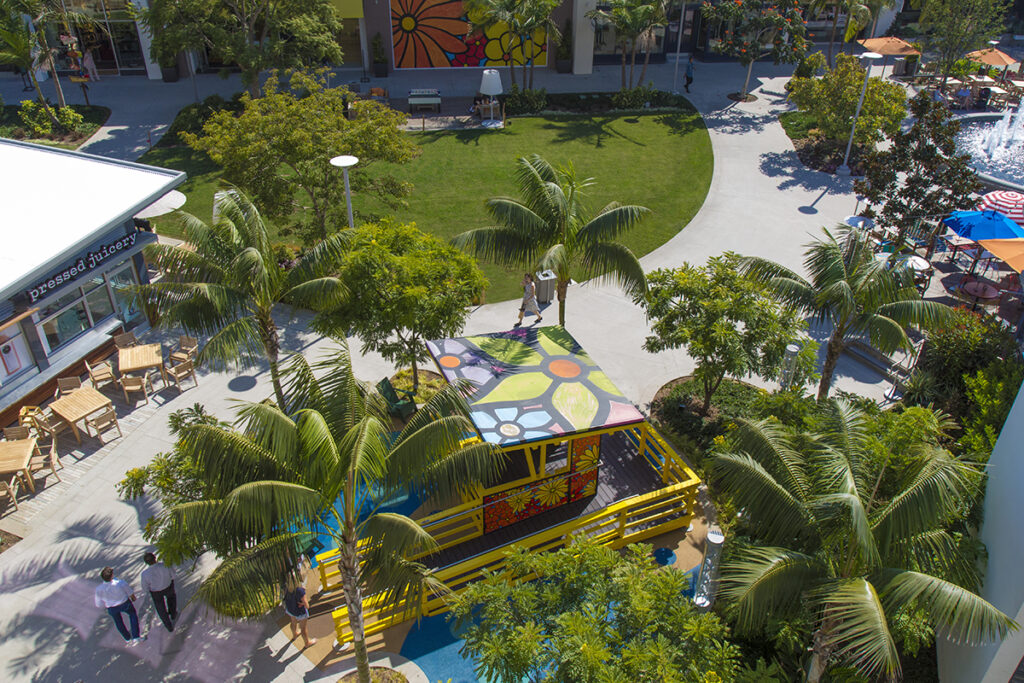 At The Point in El Segundo, CA, a variety of palms and lush planting weave through the retail center, creating sheltered moments for dining, drinking, and play. A large turf area is the central portion of the landscape, which on quiet days is an idyllic place to relax with your children and play. But, by design, it works as a central park area for a vast array of programmed elements, from concerts to yoga.
At The Point in El Segundo, CA, a variety of palms and lush planting weave through the retail center, creating sheltered moments for dining, drinking, and play. A large turf area is the central portion of the landscape, which on quiet days is an idyllic place to relax with your children and play. But, by design, it works as a central park area for a vast array of programmed elements, from concerts to yoga.
Another sense to be acknowledged is touch. A tactile environment draws people in, and the touchable qualities of the hardscape create new layers near the softscape. This ranges from the texture and color of the paving to the use of wood, metal, and glass in benches, fences, or pavilions.
The visual animation that water can bring to a landscape, as well as how it plays into our sense of hearing is not to be taken for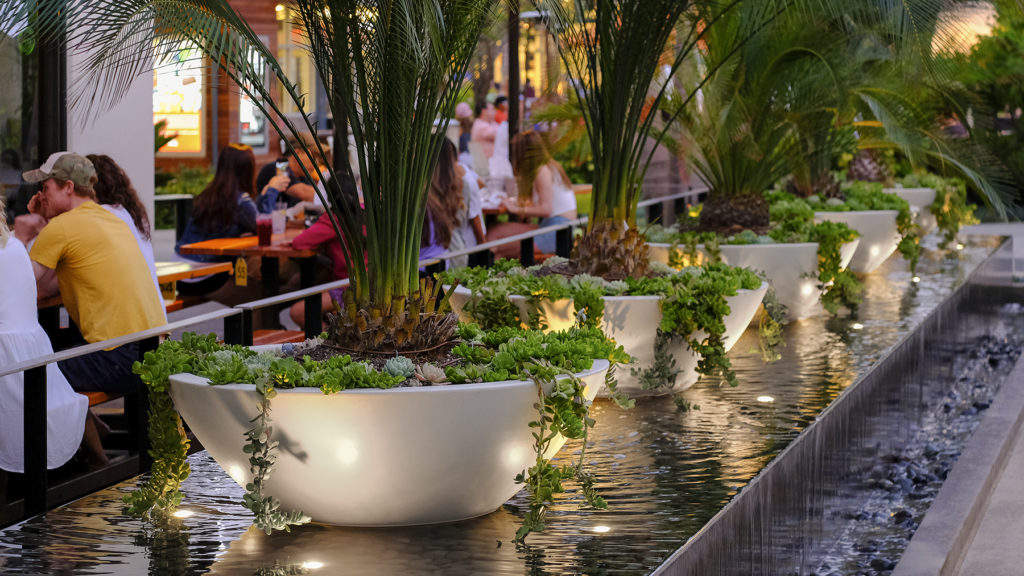 granted. Moving water, whether it is the gently rippling surface of a swimming pool or shimmering drops falling from a fountain bowl, gives a garden life and stimulates the senses of sight and sound. While its auditory qualities create comfort, they can also be used to help mitigate unwanted noises from the surroundings. Seeing and hearing water movement is also advantageous in hot climates where it psychologically aids in creating the perception that it’s cooler.
granted. Moving water, whether it is the gently rippling surface of a swimming pool or shimmering drops falling from a fountain bowl, gives a garden life and stimulates the senses of sight and sound. While its auditory qualities create comfort, they can also be used to help mitigate unwanted noises from the surroundings. Seeing and hearing water movement is also advantageous in hot climates where it psychologically aids in creating the perception that it’s cooler.
At Hotel Drover, water plays a major role throughout the gardens, and fountains anchor various outdoor spaces throughout the property. Playing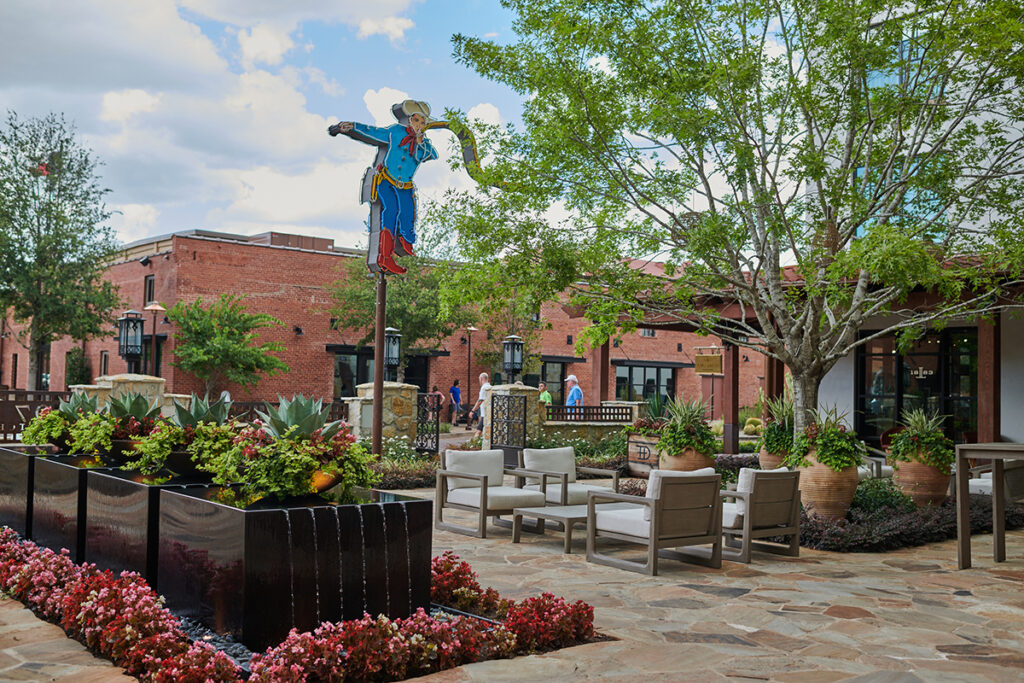 into the aged, yet modern, western design aesthetic, we sourced antique stone drinking troughs and fountains (500-year-old trough from Belgium, a 300-year-old limestone fountain from Italy, and 250-year old fountain from France) to feel like relics that have been on property for generations, but then countered that with a custom metal edging and spouts that spills over in a delicate trail of water.
into the aged, yet modern, western design aesthetic, we sourced antique stone drinking troughs and fountains (500-year-old trough from Belgium, a 300-year-old limestone fountain from Italy, and 250-year old fountain from France) to feel like relics that have been on property for generations, but then countered that with a custom metal edging and spouts that spills over in a delicate trail of water.
On the other hand, at Manhattan Village in Manhattan Beach, CA, we designed a central park to the destination retail development that was very much tied to water and the beach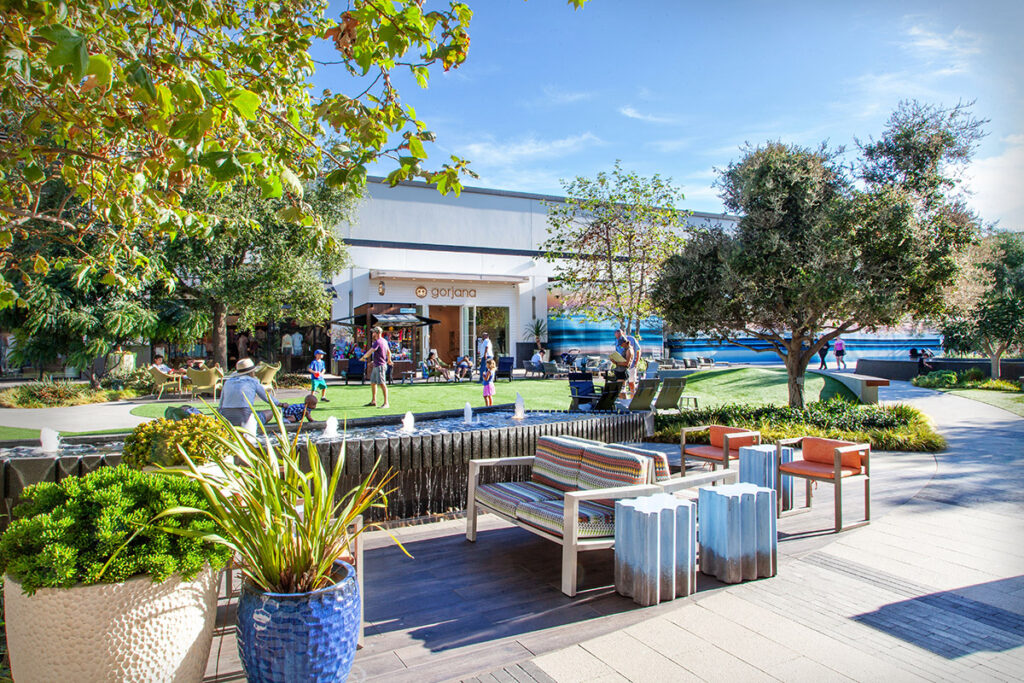 culture. Curvaceous walkways and mounded turf hint at the idea of rolling surf, while we used unique water expressions to animate the space and provide places for shoppers to interact with water in a variety of forms. A gently arching raised reflecting pool nestles against a sitting area; those walking by can run their fingers across a water layer flowing down its side. Nearby, a berm of turf rises like a cresting wave and ends at a raised fountain where very touchable streams of water pour between grooves creating a rumble like a crashing wave.
culture. Curvaceous walkways and mounded turf hint at the idea of rolling surf, while we used unique water expressions to animate the space and provide places for shoppers to interact with water in a variety of forms. A gently arching raised reflecting pool nestles against a sitting area; those walking by can run their fingers across a water layer flowing down its side. Nearby, a berm of turf rises like a cresting wave and ends at a raised fountain where very touchable streams of water pour between grooves creating a rumble like a crashing wave.
A last layer of the design involves landscape lighting, which is crucial to make sure what we design isn’t lost when the sun goes down. It too needs to be layered into the design in a way that accentuates key areas but has a rhythm of less brightly lit areas for contrast. Done correctly, nighttime lighting can take the design and amplify it into an even more dynamic experience than what you see during the day.
As you can see, there is an art to understanding the tools and creating a layered, immersive landscape environment that not only delights a guest or visitor on their first experience but calls them to return. We would certainly want that in our own home’s landscape, but it is crucial when developing gardens for hotels, retail centers, multi-family, and mixed-use developments because it directly equates to return stays, higher sales, and higher lease rates. Our expert landscape architects and horticultural team at Lifescapes have spent decades designing and working in the field to ensure that every project doesn’t just function well but is a work of art on its own.


